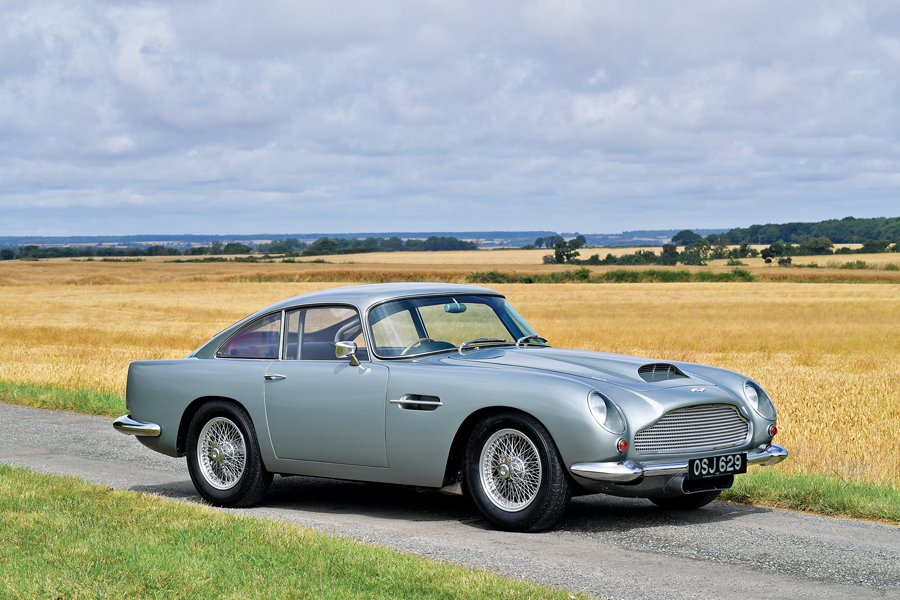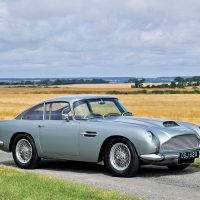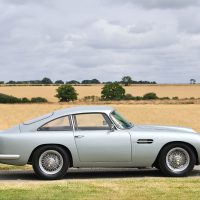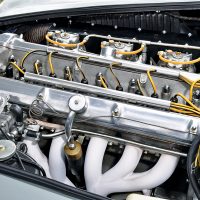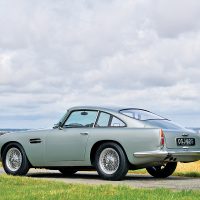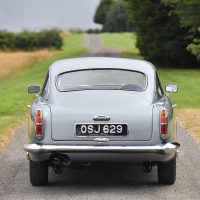The stars aligned for David Brown and Aston Martin upon the introduction of the all-new DB4 model in late 1958. A competition-oriented variant, the DB4GT, was formally introduced in September 1959 at the London Motor Show, based on the race-winning prototype DP1991.
The GT was shorter, lighter and more powerful than the production DB4. The bodywork was of thinner 18-gauge aluminium alloy, the wheelbase was reduced by five inches, and the rear seats were removed on all but a small number of special-order cars. Weight was reduced by 200 pounds.
The engine featured higher 9:1 compression, a twin-plug, dual-ignition cylinder head and triple dual-throat Weber 45DCOE carburetors. Power output was 302 horsepower at 6,000 rpm, a useful increase from the claimed 240 hp of the standard car, and qualifying the GT as the most powerful British car of its era.
Chassis 26 was sold to original owner Maurice Baring of the renowned banking family. Soon after its acquisition, he entered his GT into a competition at Brands Hatch (March 1960) and won the race. This was the sole occasion that this car took to the track in its early life, and one reason why it has survived largely in its original state.
SCM Analysis
Detailing
| Vehicle: | 1960 Aston Martin DB4GT |
| Years Produced: | 1959–63 |
| Number Produced: | 75 |
| Original List Price: | £4,534 ($12,687) |
| SCM Valuation: | Median to date, $2,090,000; high sale, $4,939,193 |
| Tune Up Cost: | $2,000–$3,500 |
| Distributor Caps: | $187.88 (two required) |
| Chassis Number Location: | Stamped on plate on right side of firewall |
| Engine Number Location: | On chassis plate and on left of cylinder block next to dynamo |
| Club Info: | Aston Martin Owners Club |
| Website: | http://www.amoc.org |
| Alternatives: | 1951–58 Pegaso Z-102, 1959–61 Ferrari 250 GT SWB, 1989–91 Aston Martin DB4GT Zagato Sanction II |
| Investment Grade: | A |
This car, Lot 169, sold for $3,226,720, including buyer’s premium, at RM Sotheby’s Battersea Park auction in London, England, on September 7, 2016.
The short-wheelbase DB4GT was Aston’s Ferrari beater, built to counter the 250 GT Tour de France. Ferrari answered with the potent 250 GT SWB, and then Aston introduced the lightweight DB4GT Zagato. And so on, until Ferrari launched its GTO in February 1962 and Low Drag E-types joined the fray — but that’s another story.
Of the 75 factory DB4GTs built (there have been a handful more made since, chopped from regular DB4s), 45 were right-hand drive and 30 were left-handers. Like the Lightweight version of the Porsche RS 2.7, they have gathered their own mythology — but they were also damn good racing cars.
There’s a lovely story about how, when the DBR2 intended for Stirling Moss was rolled by another driver before he could get into it at the 1959 Bahamas Speed Week, the Works “borrowed” back a DB4GT (0103L) just delivered to a Caribbean customer and Moss used it to win the next race — in a car plucked from the parking lot. So the GT is not just a pretty face.
Original and modified
This car appeared very original — although like so many straight-six Astons, the motor has been punched out to 4.2 liters by the acknowledged experts in the game, RS Williams. This shouldn’t make a difference, as its external appearance remains unchanged, but then the temptation is to up the axle ratio so as to fully exploit the extra prod, and then you need bigger brakes and fatter rubber… and before long you’ve arrived at a different car.
Luckily, the owners appear to have resisted any further mods aside from a bigger DBS sump and a stiffer anti-roll bar, and it sits on a set of original-size Borranis. It did come with a pair of DBR1-style bucket seats, which weren’t fitted at the sale, and a roll hoop, which is removable. All sensible stuff, but right on the margin of acceptability for an “original.”
The rest of it was all good news. Never fully restored, with all body panels believed original and no evidence of accident or damage repair, it was returned several years ago to its original color of Snow Shadow Grey, which was recently freshened up by Aston Martin Works in Newport Pagnell, which built it in the first place.
The leather was lightly creased, or “nicely settled in” as we curmudgeonly old Brits like to say, and this was one of only three GTs fitted with a rear seat. It retains its original gold-embossed leather-bound owner’s handbook, rare original tool roll (complete with later tools), jack and Thor hammer, the period factory brochure introducing the DB4GT, plus MoTs going back to 1994 and its FIVA certificate.
A hands-on take
Historian Stephen Archer, whose DB4GT book co-authored with Richard Candee has just gone on sale, inspected the car for RM Sotheby’s and said, “Having spent two years on the DB4GT book and driven about 15 GTs — including Zagatos — this car is remarkable… It has not been over-restored, its original character remains totally intact, and it feels as an Aston should. Most notably, it is the nicest DB4GT I have driven. Mechanically it behaves impeccably and silently, yet makes all the right noises. The gearbox is outstanding (as many are notchy), the back axle is silent and the controls are perfectly balanced… It is utterly charming and addictive.”
So it’s one of the nicest GTs you could meet. I’d put it at about a condition 2: very nicely kept but not over-the-top shiny, and obviously enjoyed.
The money
The last DB4GT Zagato (of 19 built) to sell at auction fetched $14.3m last December (SCM# 6788358), while replicas fetch $650k–$1m. The one-off Bertone-bodied “Jet” sold for near $5m at Bonhams’ annual Aston Martin Works sale in 2013 (SCM# 6384588).
As we see from the comps list, regular DB4GTs had been climbing steadily from the $2m mark through 2013 before settling back a little. Plotting the curve is a little tricky because of so few sales, but this car popped well above it. Prior to the sale, one dealer who wanted it for a client estimated about $2.3m, clearly based on prior sales, less a little market easing.
So what happened here? In a slightly slowing market (Bonhams sold a very original but driver-quality DB5 two days later for $604,788), this was a pretty exceptional price.
English newspapers in the couple of weeks up to the sale had been pointing to a recovery in the stock markets since June’s vote to leave the European Union, promoting a generally more optimistic air — and elsewhere in this sale, RM Sotheby’s got a huge world-record $2.5m for a Porsche 993 GT3 (see “Market Moment,” p. 106).
Perhaps that slight easing back in 2014/2015 allowed the market to catch its breath, but I think this car’s originality, and the fact that these don’t come along very often, loaded the deal.
My dealer told me later he and his client would have gone up to $2.9m with premium, but “there were just too many people on it prepared to pay more, because it was so original.” The end result here was slap in the middle of the auction house’s estimate range, but I’d still call it well sold. ♦
(Introductory description courtesy of RM Sotheby’s.)
